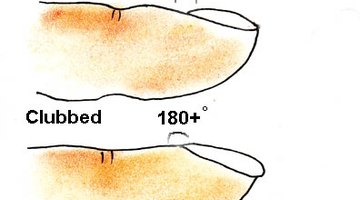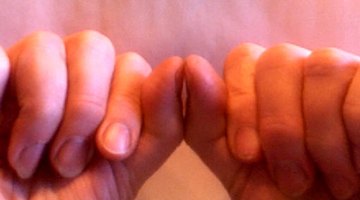With clubbing, the ends of the fingers beyond the last joint become rounded and bulbous, and the angle at the nail bases becomes more convex. The reason for clubbing is not completely understood, but it may relate to chemical changes or lack of sufficient oxygen. A genetic abnormality causes a benign clubbing in some people. However, most clubbing is evidence of pulmonary disease (such as cystic fibrosis or lung cancer), gastrointestinal disease (such as Crohn's disease or cirrhosis) or heart disease.
Development

As clubbing develops, the nail bed becomes soft, and the angle at the base of the nail (the Lovibond angle), which should be slightly concave at about 165 degrees, begins to flatten out to 180 degrees or more, and the end of the finger thickens and widens, giving the finger a club-like appearance. Over time, the nail may become ridged and take on a polished appearance.
Schamroth's Sign

Schamroth's sign is an indication of clubbing. According to doctors K.A. Myers and D.R.E. Farquhar in chapter 14 of "Clinical Examination: Evidence-Based Clinical Diagnosis," simply place the nails of the same fingers on opposing hands against each other. The space between the end joint of the finger and the tip of the finger should create a narrow diamond shape, but this shape disappears with clubbing.
- Schamroth's sign is an indication of clubbing.
- The space between the end joint of the finger and the tip of the finger should create a narrow diamond shape, but this shape disappears with clubbing.
Congenital Vessel Disorders
According to Drexell University College of Medicine, congenital heart diseases that result in lack of adequate oxygenation to the body and cyanosis (blue-tinged skin) can cause clubbing of the fingers and toes. Tetralogy of Fallot comprises four (tetra) different disorders of the heart and blood vessels: a large opening between the right and left ventricles (lower chambers), narrowing of the pulmonary artery taking blood to the lungs, displacement of the aorta taking blood from the heart out to the body, and enlargement of the right ventricle. Babies often fail to thrive and have episodes of cyanosis with crying or feeding and have little tolerance for activity as they grow. Clubbing of the fingers occurs over time if the condition is not corrected.
With total anomalous pulmonary venous return, blood circulates back and forth to the lungs but not out to the body; and with transposition of the great arteries, blood circulates back and forth to the heart and around the body but not to the lungs to pick up oxygen. In both conditions, an opening between the right and left sides of the heart is usually also present so that some oxygenated blood mixes with nonoxygenated blood and circulates to the body, but the oxygen level is low, so the child is cyanotic and develops enlargement of the heart, shortness of breath and clubbing of the digits.
- According to Drexell University College of Medicine, congenital heart diseases that result in lack of adequate oxygenation to the body and cyanosis (blue-tinged skin) can cause clubbing of the fingers and toes.
- In both conditions, an opening between the right and left sides of the heart is usually also present so that some oxygenated blood mixes with nonoxygenated blood and circulates to the body, but the oxygen level is low, so the child is cyanotic and develops enlargement of the heart, shortness of breath and clubbing of the digits.
Congenital Valve Disorder
With tricuspid atresia, the valve normally between the chambers on the right side of the heart is missing and the right ventricle is underdeveloped so that blood cannot be pumped to the lungs to pick up oxygen. An opening usually occurs between the right and left sides of the heart or one is created surgically so that blood can mix, but oxygen levels may not be adequate, resulting in cyanosis and clubbing.
Infective Disorder
Bacterial endocarditis is an inflammation of the endothelium (inside lining) of the heart and heart valves, causing deformation of the valves. Various microorganisms, such as Streptococcus or Staphylococcus, can cause endocarditis. The bacteria may invade other heart tissue, interfering with function. Over time, the person may become weak and develop anorexia, weight loss and an enlarged spleen and liver. Because the heart cannot function properly, the person develops cyanosis and clubbing of the fingers.
- Bacterial endocarditis is an inflammation of the endothelium (inside lining) of the heart and heart valves, causing deformation of the valves.
Considerations
While clubbing often indicates disease, some healthy people may develop some degree of clubbing, but a complete physical examination to rule out serious disorders is indicated if clubbing becomes evident .
